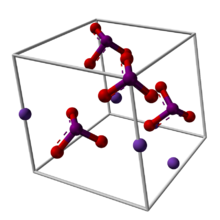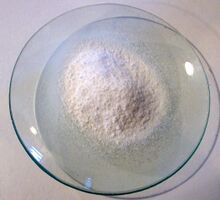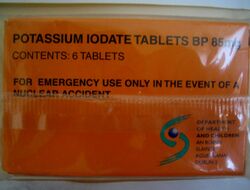Chemistry:Potassium iodate

| |

| |
| Names | |
|---|---|
| IUPAC name
Potassium iodate
| |
| Other names
Iodic acid, potassium salt
| |
| Identifiers | |
3D model (JSmol)
|
|
| ChemSpider | |
| DrugBank | |
| EC Number |
|
PubChem CID
|
|
| RTECS number |
|
| UNII | |
| |
| |
| Properties | |
| KIO3 | |
| Molar mass | 214.001 g/mol |
| Appearance | white crystalline powder |
| Odor | odorless |
| Density | 3.89 g/cm3 |
| Melting point | 560 °C (1,040 °F; 833 K) (decomposes) |
| 4.74 g/100 mL (0 °C) 9.16 g/100 mL (25 °C) 32.3 g/100 mL (100 °C) | |
| Solubility | soluble in KI solution insoluble in alcohol, liquid ammonia, nitric acid |
| −63.1·10−6 cm3/mol | |
| Hazards | |
| GHS pictograms |   
|
| H272, H302, H318 | |
| P210, P280, P301+312+330Script error: No such module "Preview warning".Category:GHS errors, P305+351+338+310 | |
| NFPA 704 (fire diamond) | |
| Flash point | Non-flammable |
| Related compounds | |
Other anions
|
Potassium chlorate Potassium bromate |
Other cations
|
Sodium iodate |
Related compounds
|
Potassium iodide Potassium periodate |
Except where otherwise noted, data are given for materials in their standard state (at 25 °C [77 °F], 100 kPa). | |
| Infobox references | |
Potassium iodate (KIO3) is an ionic chemical compound consisting of K+ ions and IO3− ions in a 1:1 ratio.
Preparation and properties
Potassium iodate is an oxidizing agent and as such it can cause fires if in contact with combustible materials or reducing agents. It can be prepared by reacting a potassium-containing base such as potassium hydroxide with iodic acid, for example:[1]
It can also be prepared by adding iodine to a hot, concentrated solution of potassium hydroxide:[1]
Or by fusing potassium iodide with potassium chlorate, bromate or perchlorate, the melt is extracted with water and potassium iodate is isolated from the solution by crystallization:[2]
- KI + KClO3 → KIO3 + KCl
The analogous reaction with potassium hypochlorite is also possible:[3]
KI + 3KOCl → 3KCl + KIO3
Conditions/substances to avoid include: heat, shock, friction,[4] combustible materials,[1] reducing materials, aluminium,[4] organic compounds,[1] carbon, hydrogen peroxide and sulfides.[4]
Applications
Potassium iodate is sometimes used for iodination of table salt to prevent iodine deficiency. In the US, iodized salt contains antioxidants, because atmospheric oxygen can oxidize wet iodide to iodine; other countries simply use potassium iodate instead.[5] Potassium iodate is also an ingredient in some baby formula.[6]
Like potassium bromate, potassium iodate is occasionally used as a maturing agent in baking.[7]
Radiation protection

Potassium iodate may be used to protect against accumulation of radioactive iodine in the thyroid by saturating the body with a stable source of iodine prior to exposure.[8] Approved by the World Health Organization for radiation protection, potassium iodate (KIO3) is an alternative to potassium iodide (KI), which has poor shelf life in hot and humid climates.[9] The UK, Singapore, United Arab Emirates, and the U.S. states Idaho and Utah all maintain potassium iodate tablets towards this end.[citation needed] Following the September 11 attacks, the government of Ireland issued potassium iodate tablets to all households for a similar purpose.[10]
| Age | KI in mg | KIO3 in mg |
|---|---|---|
| Over 12 years old | 130 | 170 |
| 3 – 12 years old | 65 | 85 |
| 1 – 36 months old | 32 | 42 |
| < 1 month old | 16 | 21 |
Potassium iodate is not approved by the U.S. Food and Drug Administration (FDA) for use as a thyroid blocker, and the FDA has taken action against US websites that promote this use.[12][13]
References
- ↑ 1.0 1.1 1.2 1.3 Lyday, Phyllis A.; Kaiho Tatsuo (26 November 2015). "Iodine and Iodine Compounds". in Ley, Claudia. Ullmann's Encyclopedia of Industrial Chemistry (7th ed.). Weinheim: Wiley-VCH. p. 9. doi:10.1002/14356007.a14_381.pub2. ISBN 9783527306732.
- ↑ Pradyot Patnaik. Handbook of Inorganic Chemicals. McGraw-Hill, 2002, ISBN:0-07-049439-8
- ↑ Andrews, Launcelot W. (July 1903). "Titrations with potassium iodide". Journal of the American Chemical Society (Easton, PA: US Postal Service) 25 (7): 756. doi:10.1021/ja02009a012. https://babel.hathitrust.org/cgi/pt?id=uc1.%24b811386&seq=113.
- ↑ 4.0 4.1 4.2 Regulatory Affairs (23 March 2023). "Safety Data Sheet". Thermo Fisher Scientific. https://www.fishersci.com/store/msds?partNumber=AC418245000&productDescription=POTASSIUM+IODATE%2C+REAGEN+500GR&vendorId=VN00033901&countryCode=US&language=en.
- ↑ Arroyave, Guillermo; Pineda, Oscar; Scrimshaw, Nevin S. (1956). "The stability of potassium iodate in crude table salt". Bulletin of the World Health Organization 14 (1): 183–185. PMID 13329845.
- ↑ James, Maia (2023-04-04). "Best Baby Formula Guide" (in en-US). https://gimmethegoodstuff.org/safe-product-guides/safe-infant-formula-guide/.
- ↑ Carson, Lin, ed. "Potassium iodate". BAKERpedia. Portland, OR. https://bakerpedia.com/ingredients/potassium-iodate/. Retrieved 22 September 2023.
- ↑ Astbury, John; Horsley, Stephen; Gent, Nick (1999), "Evaluation of a scheme for the pre-distribution of stable iodine (potassium iodate) to the civilian population residing within the immediate countermeasures zone of a nuclear submarine construction facility", Journal of Public Health 21 (4): 2008–10, doi:10.1093/pubmed/21.4.412, PMID 11469363, http://jpubhealth.oxfordjournals.org/cgi/reprint/21/4/412
- ↑ Pahuja, D.N.; Rajan, M.G.; Borkar, A.V.; Samuel, A.M. (Nov 2008), "Potassium iodate and its comparison to potassium iodide as a blocker of 131I uptake by the thyroid in rats", Health Physics 65 (5): 545–9, doi:10.1097/00004032-199311000-00014, PMID 8225995
- ↑ "Decision to Discontinue the Future Distribution of Iodine Tablets". http://www.dohc.ie/press/releases/2008/20080403c.html.
- ↑ Guidelines for Iodine Prophylaxis following Nuclear Accidents, Geneva: World Health Organization, 1999, https://www.who.int/ionizing_radiation/pub_meet/Iodine_Prophylaxis_guide.pdf
- ↑ "Potassium iodide vs potassium iodate. Which one works?". http://www.nukepills.com/potassium-iodate-vs-potassium-iodide.html.
- ↑ W. Charles Becoat (29 May 2003). "Potassium Iodate Warning Letter". Food and Drug Administration. http://www.nukepills.com/docs/Potassium%20Iodate%20warning%20letter.pdf.
 |


